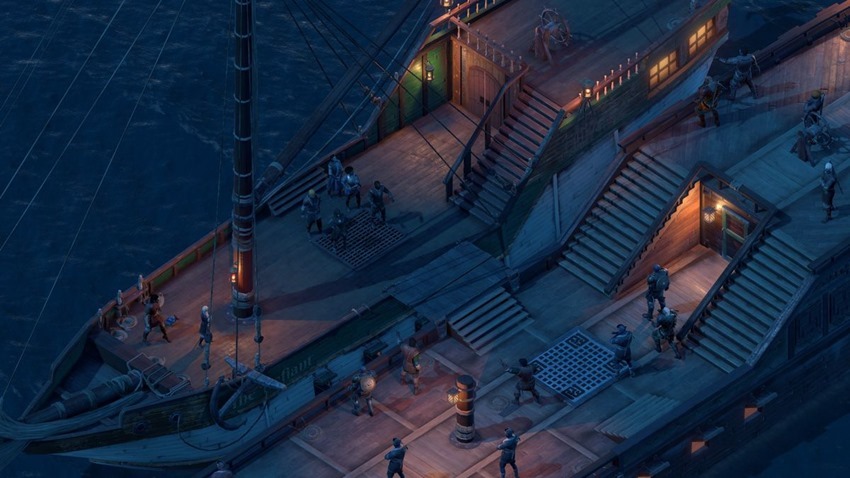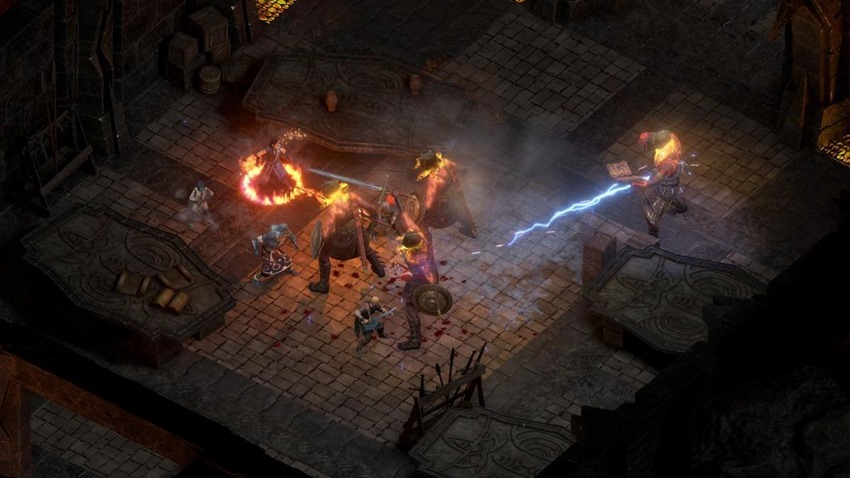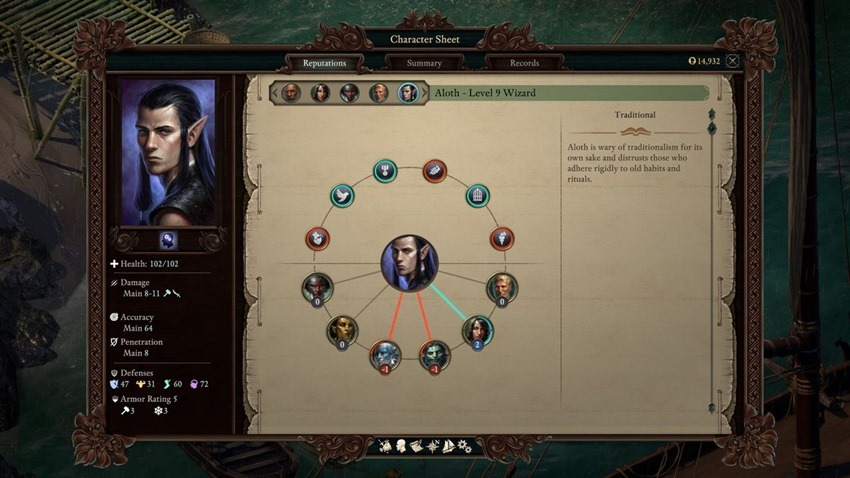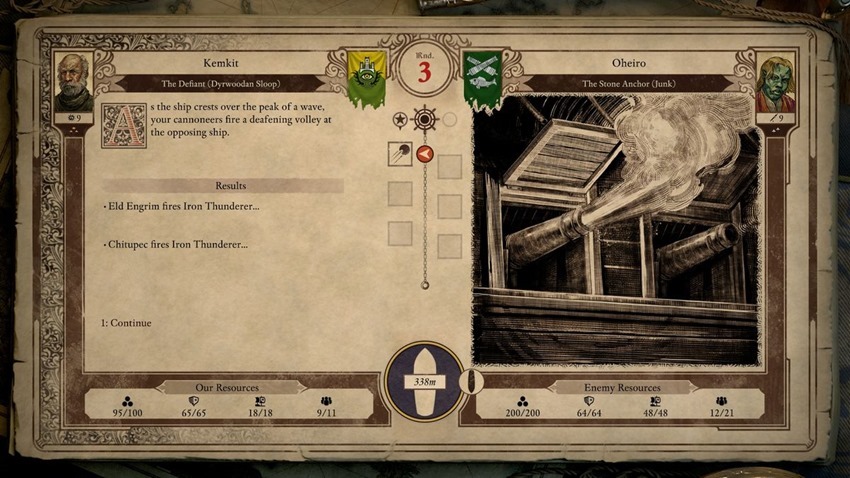One night, several years after the events of the original Pillars of Eternity, the keep of Caed Nua erupts. From the catacombs below, the colossal adra sculpture that had previously lain inanimate hefts itself up from its tomb of dirt. In the wake of its emergence the keep is rendered to ruin, its inhabitants dead and their souls taken by the pilfered by the giant. Eothas, god of light and rebirth, has been reborn into to the mortal world and embodied himself within the monolithic crystal sculpture. He marches fort, uncaring, driven with unknown intent, wreaking death and destruction in his wake.
Tasked by the Goddess Berath to trail Eothas, you track him to the Deadfire Archipelago, an island cluster squirming under a three-way tussle of political and naval powers; The Vailian Trading Company have muscled into the Deadfire to study and mine its unique Adra resources. The Rauataian government and their Royal Deadfire Company lay claim to the Deadfire Archipelago and wish to ensure both the safety of their people and stability within the Deadfire. Finally, the Príncipi sen Patrena are a loosely connected and regulated organisation of pirates that terrorise the surrounding seas. The ruinous passing of Eothas enflames the tension between these factions, and while they pester you to resolve the issue, they also see an opportunity to use you for their own ends.

The story in Pillars of Eternity 2 is set on a much grander scale than the previous game, and while it could be played as a standalone without much issue, it very much builds on the story framework of events and revelations of the first game. The story of the first game did the arduous (and at times somewhat overwhelming) busy work of revealing the history of the world, freeing the sequel to be bolder in its approach. The result is that your objective in Pillars of Eternity 2 is clear and evident from the start, which is a wonderful change from the vague wandering and slow reveal of the previous game. Here, you know what you need to do – it’s how you go about doing it that matters. This freedom allows the game to explore the world and flesh it out, which goes hand in hand with its emphasis on exploration.
Your choices in the first game do carry over to the sequel, and affect how some people choose to speak with you, and how they view you. You can load a save, but you can also answer some questions if you’d prefer to tailor your results or if you simply haven’t played the first game. The character you play as has no bearing on if you load a save or not, allowing you to create a completely new character, rather than getting stuck with your original class.

Speaking of story, one of the very first things one notices about the sequel as the introductory narration begins is the astounding voice acting. The vast majority of the conversations you have are fully voice acted, but special praise should be given to the voice of the narrator as she describes the more important story moments. The voice is wonderfully evocative, both wistful and passionate, as it describes the events unfolding. The vocal skill doesn’t end there – the entire cast is superb in their roles, though those of you who very familiar to the YouTube roleplaying series Critical Role may find it a bit surreal to encounter the voices of the entire cast all throughout the game, including many of your party.
The cinematic visuals are almost always static, as they were in the first game, but are now also beautifully illustrated, with wonderful and fantastical use of colour. The writing is fantastically descriptive and evocative, allowing one to feel fully immersed in the moment. All of these combine to create a dream-like narrative experience reminiscent of storybooks being read to one as a child, your eyes wide as your imagination blooms in wonder.

The wonderful moments of background character interactions are back as well, which are gold for humour or subtle character depth. One of my favourite moments in the first game involved Edér interacting with Sagani’s wolf, and I was overjoyed to see that quietly touched on with the animal companion of one of the new characters.
Quite a few mechanics have been improved and polished, the most immediate example being when one levels characters. Whereas in the first game one had to browse through lists when choosing new abilities for characters, there’s now a skill tree that, while mechanically similar, allows for far greater ease in browsing one’s choices. When travelling to locations, upon reaching it you can often choose to warp directly to one of the places of interest you’ve already discovered within that location. Your party AI seems considerably more competent off the bat, and at times I left the party to fight by itself, as they seemed to be making the right choices. The game feels overall much improved by these changes.
As for new content, characters care about each other far more now. The character personalities are far stronger, and the game is far more comfortable at throwing characters at you that you may strongly dislike off the bat, and the rest of your party will react to them as well. Conflicting views over religion, behaviour, or acts of skulduggery can eventually result in outright arguments between party members that you have to resolve (or stay out of, but that will send its own message).

Characters can grow great affection for one another as well, in ways that can potentially shift their own worldview. How they treat you, and how they treat others, are also largely influenced by how you choose to resolve situations. Choosing duty and professionalism may impress one party member to like you more, whereas one who sees more value in deceit and selfishness will be disappointed in you. This isn’t quite as in-your-face as a Tell-Tale-esque “This Character Will Remember That” message, but as you interact with the world, the game will send you small titbits on the body language of your party members, clueing you in on how they’re reacting, and whether they approve.
The way that combat mechanics have evolved is also very interesting. The maximum health of characters now only drops when a character is knocked out, and three knockouts are potentially fatal. Spells and abilities are now refreshed after each encounter, rather than having to use campfires or Inns to regain them, and in fact, campfires are no longer a mechanic at all, as food can be given to party members to allow them to recover. The overall combat and damage system feels considerably smoother as a result, allowing for further forays into dungeons without having to break it up with returns to safe havens or expending limited campfire supplies. Beyond that, combat is largely the same: real-time combat that you can pause to issue orders, with cool downs in between every character action. Reacting to situations quickly is still immensely important, and learning to read and respond to the environment is crucial – the real-time nature of the game can easily result in a character dying astonishingly quickly if you’re not paying attention, and threats can often only be evident after it’s far too late.

Exploration is now hugely expanded, something that’s immediately obvious near the start of the game. Rather than having a map with places that you can fast travel to, you now move around the map itself, exploring places of interest. Many of this are just areas where you can collect food and water for your ship (more about this in a bit), some are narrative encounters where you can find some equipment or some foes to fight, and some are dungeons hidden away. While the individual islands may be small, the naval map itself is immense in size, so much so that exploring it all may seem daunting at first. The island cities have their own map showing the various districts, and there’s the chance you may encounter events as you travel between districts.
Your ship is what you’ll be using to get to these islands, another new mechanic the game provides. There are some obvious and immediate similarities between the ship and the keep you manage in the previous game, but while the keep often fell into the background and could be ignored for the larger part, your ship is far more upfront in its use and in your desire to manage aspects of it. Your crew need pay, but also food and water to keep morale up, giving sudden importance to all the food one and drinks one finds lying about.
The ship isn’t merely a vessel to move you between locations, however. Whether you’re hunting bounties, or defending yourself, ship combat is an important aspect to your survival and prosperity within the Deadfire Isles. When you encounter a hostile ship in the seas, the combat takes place over two “phases”; Narrative combat and boarding combat. The former is similar to the narrative scenes one may encounter while adventuring, though your choices alternate with those of the enemy ship. It’s here that you’ll choose how to manoeuvre the ship, and when to fire your cannons. When the two ships are close enough, one can initiate boarding – this shifts to the more traditional combat, where one crew fights the other, the winner taking the spoils. Destroying the ship with cannons poses less risk to your crew, while a successful boarding action will result in considerably more rewards. Ship combat is quite enjoyable, but an activity where you can found yourself outmatched very quickly if you’re not adequately prepared or equipped.

There’s a fair bit of trial by fire when it comes to ship combat and exploration, though – while the game flings tutorials at you, it’s another thing to remember everything in the deluge of information, and it will take a few moments until you learn and understand how things work. As an example, I spent an embarrassing amount of time being frustrated as I couldn’t understand why my ship kept losing morale (nor could I understand how I could gain morale) until I realised the cheap food and water I was feeding them caused a constant morale drain.
It’s difficult to find issue with a game that seems to have expanded and improved itself to such a degree. One of the common issues many had with the first was the unexpected difficulty in combat encounters, and particularly in how that difficulty curve tended to leap suddenly at times. While it’s difficult to say it’s an issue that’s been fully fixed, the difficulty does feel far smoother in how it scales, though there are still moments where things feel a bit too up-scaled, even when the game insists it’s a level appropriate encounter. Some of the random encounters, particularly in the largest city, can be frustrating when you’re just looking to finish up errands, and it can be quite frustrating to be caught in a storm that’s roaming the map because your ship was auto-moving across the map and you weren’t paying attention. However, these issues feel more like nit-picks, made worse simply by contrast to how wonderfully everything else has been put together.
Last Updated: May 21, 2018
| Pillars of Eternity II: DEadfire | |
|
If you enjoyed the first Pillars of Eternity, then there’s a damn good chance you’ll mine even more enjoyment out of the sequel. Quite a few of the smaller niggling issues that hampered the first game have been addressed, and you’re certainly not as burdened to remember nearly as much history to understand character motivations. If you’re new to the franchise, you’ll be a bit under pressure to read up on characters and events from the first game, but it caters to new players (or those who have simply forgotten everything from the first game) well enough, is one of the best story-telling experiences I’ve had in recent memory, and is otherwise bloody fantastic isometric RPG.
|
|
|---|---|
| Pillars of Eternity II: DEadfire was reviewed on PC | |
|
88 /
100
| |




















